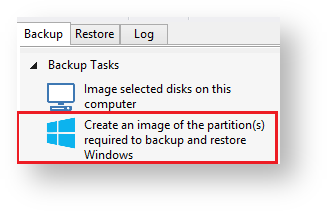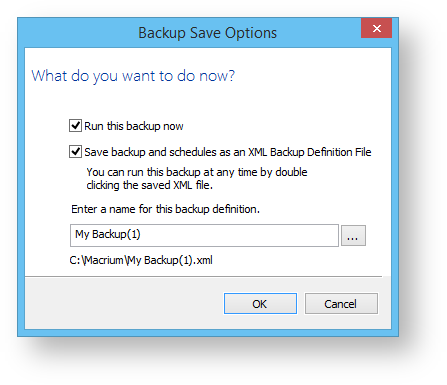Using Microsoft Volume Shadow Copy Service (VSS) Macrium Reflect creates 'point-in-time' persistent images of your system. In Addition to creating backups of all partitions required to backup and restore Windows, you can backup all or selected drives and partitions on the PC.
| Info |
|---|
| You need to have Macrium Reflect installed on the machine you wish to backup. |
Starting the Image Wizard
The Image Wizard can be started in multiple ways...
By selecting 'Image selected disks on this computer'.
Using this option will populate the Image Wizard with all selected disks and partitions in the application main Window.By selecting 'Create an image of the partition(s) required to backup and restore Windows'.
Using this option will choose all the partitions required to boot Windows. This may include hidden system partitions that are essential for Windows to start and run.By Selecting a disk in the application main Window and click 'Image this disk...'.
By Selecting a disk in the application main Window, click on a partition, then click 'Actions' and select 'Image this partition only...'
| Anchor | ||||
|---|---|---|---|---|
|
The first page of the Image Wizard shows the selected disks and partitions to be included in your Image and allows you to choose a destination.
In the Destination section, enter the target backup folder.
You can type the destination path or click the browse button to choose a folder. The destination path can be on a local drive or network share.Info Note: You cannot enter a path that is located in any of the partitions included in the Image. The recommended name for your Image file is the unique backup set identifier {{ImageID}}. We recommend that you always use this recommended setting as choosing your own name can cause file name collisions. Please see How backup sets are created and maintained for more information on backup file naming.
Click 'Next'. to edit the Backup Plan for this image or click 'Finish' to save and/or run the Image now.
| Anchor | ||||
|---|---|---|---|---|
|
The second page of the Image Wizard is where you create or edit your 'Backup Plan'. This defines the backup schedules and retention rules for your backup.
| Include+ | ||||||
|---|---|---|---|---|---|---|
|
Click 'Next'. to view a summary of all settings for this image or click 'Finish' to save and/or run the Image now.
| Anchor | ||||
|---|---|---|---|---|
|
The final page of the Image Wizard displays all settings used for creating this image.
Click Finish to Run and/or save your Image definition.
Saving the backup definition
You are now given the opportunity to save the backup options.
| Info |
|---|
| Note: Saving a backup definition enables you to run your backup Image at any time with a single click |
| Info |
|---|
| Note: You must save your backup definition if you have created backup schedules. Your schedules cannot run if this step is missed. |
If you want to run the backup at this point, select 'Run this backup now' and click OK.
| Conditional Content | |||||||||||||||||||||||||
|---|---|---|---|---|---|---|---|---|---|---|---|---|---|---|---|---|---|---|---|---|---|---|---|---|---|
| |||||||||||||||||||||||||
Related articles
|








